
(Photos: M.Andersen/BikePortland unless noted)
Boris Kaganovich was talking quickly, as he often does, when he walked past the button-activated pedestrian signal at Northeast 60th and Glisan. Without breaking stride, he slammed the heel of his hand into the button and kept walking in another direction.
The lean, curly-haired 30-year-old grinned a little too widely.
“I just hit those whenever I walk past them,” he explained cheerfully.
It was August 2014, and if Kaganovich was acting a little like a cat who had eaten the canary and gotten away with it, he could probably be forgiven. Almost no one in town knew it yet, but the indisputably radical livable-streets advocate had realized that he was about to pull off one of the biggest heists of his life: a three-day demo of what 3rd Avenue downtown could be like if more than 80 percent its space were reassigned from cars to people.
“Nobody is saying no,” he said, giddy with excitement. “Nobody is saying no.”
It was a vision — a 12,000 square foot plaza in front of Voodoo Doughnut plus four blocks of a protected bike lane and expanded sidewalks — that had been on almost no one’s radar. The concept couldn’t be found in the city’s $812 million transportation system plan, the Bicycle Transportation Alliance’s 16-point Blueprint for World-Class Bicycling or the Central City Plan that city staffers and official stakeholders had been honing for years.
Kaganovich, whose day job was as a communications engineer working on TriMet’s Orange Line, was in his element: improvising.
Eight months later, as he and his wife and collaborator Melissa Kaganovich prepare to leave this adopted hometown for their next one, Toronto, the Kaganoviches say they’re hoping to leave Portland with a powerful and unfamiliar insight.
Sometimes, improvisation works.
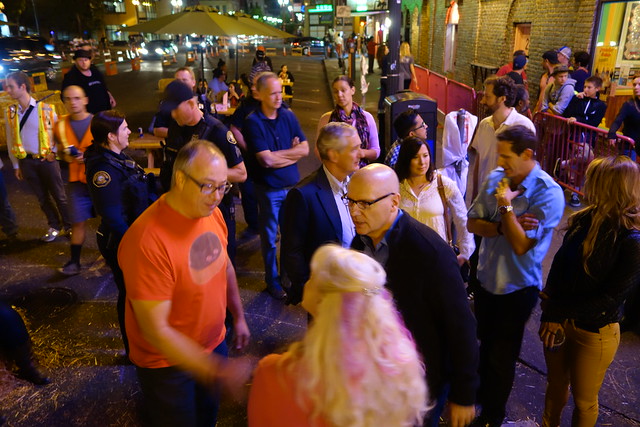
(Photo: Greg Raisman)
Inspired by New York City
The Kaganoviches started dating in New York City after a boozy 2009 holiday party for Transportation Alternatives volunteers. As the party broke up, Melissa hitched a ride on the rear rack of Boris’s cargo bike.
“Classic love story,” Melissa, now 28, recalled in an interview Thursday.
Boris had gotten into bicycle culture in Minneapolis, lured in by the Twin Cities tradition of bike-fun events like the Stupor Bowl, which he describes as “kind of like a scavenger hunt in snow on bicycles.” For Melissa, the origin had been commuting: after getting in a low-speed car crash, she’d stopped driving to her job at a publishing house and realized that a 20-mile daily bike commute was teaching her more about her city than she’d realized there was to learn.
They met in Queens, where Melissa had grown up — Nicki Minaj was a few years ahead of her in middle school — and had been volunteering as a political and community advocate.
Around that time, strange things had started happening in New York City: Big, strange things like removing most of the auto traffic from the most famous intersection in the United States.
“I remember all of my friends going, this is the most ridiculous and stupid thing ever — why would they close a street to improve traffic?” Melissa recalled of the Times Square transformation, which began on Memorial Day 2009 when the city dropped 326 lawn chairs in the middle of the street. “And then I remember visiting and it being the best part of downtown.”
NYC Transportation Commissioner Janette Sadik-Khan described it as a trial. It became one of Mayor Michael Bloomberg’s signature achievements and the crowning success of New York City’s rapid shift to lead the country in creating protected bike lanes, plazas, street seating and other new uses of public road space.
“I started meeting more bicyclists,” Melissa said. “At the time, I didn’t realize that this was a JSK revolution or anything.”
It wasn’t until a recent visit home that Melissa saw how much the work of those years had changed her city.
“My parents’ neighborhood, so many people were riding their bikes now,” she said. “Those were the people who were like, ‘Who rides their bike? no one does.'”
New York’s metamorphosis was the sort of victory that creates visionaries. And also that year, the Kaganoviches were hearing a lot about another city that had helped inspire New York’s efforts. They started to talk about moving west.
“This is what American cities used to look like”
Boris’s powerful feelings about cities began, he said, with a family vacation.
He was living outside Minneapolis with his parents, structural engineers who had illegally left the Soviet Union in 1989.
“I guess I was in 7th or 8th grade,” Boris said. “I lived in the suburbs. My parents took me to Paris, and then I went home and realized something was missing.”
Later, he started riding a bicycle.
“The more and more I rode, the more I realized that the most interesting places to ride were these streets with storefronts and people,” Boris said. “The memories of childhood, the stuff that I saw in Paris, kind of clicked. And then I found some cool historical books and I was like, wait, this is what American cities used to look like. Why did we throw it in the trash? That was so stupid!”
By his junior year in college, it became what most people would describe as an obsession. Boris learned about an abandoned streetcar tunnel in a run-down part of St. Paul.
So, at age 21, he decided to drop out of college to start a for-profit streetcar company to carry people between two business districts on either side of the tunnel.
“The business plan was mostly sound,” Boris says today. “It’s possible to make a transit system that breaks even. … You can build it with private capital, and basically the investment for that transit line comes from the property owner.”
Boris put together a 70-page prospectus and started contacting the owners of nearby buildings to convince them to invest in what he called the “St. Paul Streetcar Company.”
“My goal was to activate their storefronts and fill their offices upstairs,” Boris said.
The landlords, largely out-of-town institutions, didn’t bite.
“After six months I realized, oh shit, I need to graduate,” Boris said.
The tunnel remains abandoned, and Boris still has a copy of his business plan.
“It still makes sense,” he said.
Advertisement
In New York, Boris had been working a mechanical job at Amtrak. In 2011, as TriMet started hiring people to build its new Orange Line, he decided to apply.
When he flew in for an interview, Boris said, TriMet “presented me with a warm cookie and loaned me a bicycle.” He was sold.
Melissa moved with him to Portland and, after a job search, was hired by Nike to do analytics for its website.
Looking for ways to be part of their new city, the couple joined the city’s pedestrian advisory committee, which led them to meet other young urbanists like Kai Bates, Jonathan Winslow and Katrina Johnston-Zimmerman. Then, in 2013, the new social circle discovered a video of a TedX talk by a Dallas-area activist named Jason Roberts.
Roberts had created an organization called Better Block with a goal of creating temporary events designed to bring NYC-style street transformations to the rest of the country.
“I was like, you guys, we’ve got to watch this,” Kaganovich said. “We’d met up later that week. … After a few beers and some pizza, we were like, let’s just build some stuff.”
PARK(ing) Day, the annual festival of repurposed parking spaces, was just weeks away, but the group decided there was no time like the present. They spent what Boris describes as “the busiest three weeks ever” creating what turned out to be the most spectacular PARK(ing) Day event the city has seen: a block-length parklet in front of the Ace Hotel along Southwest Stark Street.
Better Block PDX had been born.
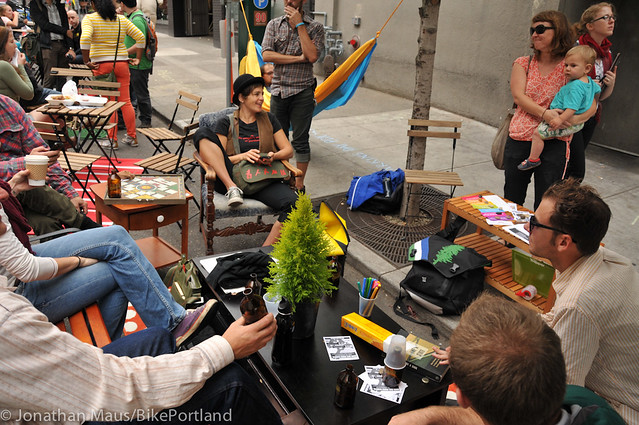
(Photo: J.Maus/BikePortland)
“It was my life for three months”
Better Block PDX’s projects on Stark and, the following spring, on Clinton Street, got attention. Portland’s rich, loosely knit network of livable-streets activists, many of them also inspired by New York City, began to “come out of the woodwork,” as Boris Kaganovich likes to put it.
By last year, he had a sense that they were ready for their biggest challenge yet.
So when he read about a group of Old Town business owners frustrated by the city’s lack of interest in removing parking or auto travel lanes from 3rd Avenue, he decided to spring into action.
The city wanted to integrate the businesses’ suggestions into its many overlapping long-range planning efforts for downtown. The business owners wanted their street to change as soon as possible.
Boris decided that if the city wouldn’t install planter barriers to create a new 3rd Avenue bike lane and repurpose the old streetcar turnaround in front of Voodoo Doughnut into a pedestrian plaza, Better Block would.
“It was my life for three months,” Boris said.
Better Block’s other volunteers, including Melissa, put in many hours of their own. But no one came close to Boris’s commitment.
“The only reason I was able to do that project was that I worked downtown,” Boris said. “During lunch I could sneak away, meet with the fire department, police department.”
It had echoes of his months with the St. Paul Streetcar Company. But this time, in Portland, Boris started finding people — traffic engineers Lewis Wardrip and Peter Koonce, city livable streets specialist Greg Raisman, Transportation Director Leah Treat — who would tell him “yes.”
“This is the thing: when you come to the city and they say no and sort of shrug off your idea, you’ve got to come back at least three or four times until they say, ‘Oh, ok,'” Kaganovich said. “You’ve got to find out why they said no and come back with a tweak or a fix.”
It wouldn’t have worked in New York, he said, where all change was driven by the city government.
“In New York, you’d be like, ‘Hi.’ ‘You want to do that? No,'” Boris said. “If they listened to you at all.”

“This is the cheap, correct way to build infrastructure”
By the last two weeks before the 3rd Avenue demo, Boris was working on site every day, often from 5 p.m. to 11 p.m., supervising a steady flow of volunteers into an improvised shop in the abandoned warren of unfinished rooms above the Dixie Tavern.
The biggest job: assembling 150 wooden planters that Boris had designed to fit into the weekend event’s $10,000 budget: $11 apiece.
“We brought in two truckloads of plywood plus another two truckloads of 2x4s and then carry all this stuff up to the third floor because there wasn’t an elevator,” Boris said. “And then we had to build all this stuff in three weeks.”
The Kaganoviches say Boris was motivated by his conviction that if the event worked, it could transform not just 3rd Avenue, but the entire way that Portland — and eventually, cities across the country — plan their streets.
“It doesn’t cost a fortune to build an amazing street. Let’s fix our city in three to four years.”
— Boris Kaganovich at the Oregon Walks Weston Awards, 2014
“This is the cheap, correct way to build infrastructure,” Boris says. “Whether it’s in the suburbs, the city, anywhere. You build it iteratively and cheaply. … Portland spends way too much time working on master plans and not putting stuff on the ground. Once you get something on the ground, you can build on it two or three blocks at a time.”
“Our next generation of traffic engineers, if they can learn the Better Block build-it-cheap-build-it-later-properly model, this is the way that traffic engineers all over the country can build things,” he says. “This is the way we can build our way out of this infrastructure hole.”
It was a vision Boris spelled out for a cheering audience last November, when the couple and other Better Block volunteers took the stage to accept a Weston Award from Oregon Walks in recognition of their triumphant 3rd Avenue demo several weeks before.
“We can demonstrate with our projects how to reinvigorate our historic commercial districts,” Boris told the crowd. “It doesn’t cost a fortune to build an amazing street.”
“Come to us — let’s build these projects,” he went on. “Not in a 30-year plan, not in a 40-year plan. Let’s fix our city in three to four years.”

(Photo: Oregon Walks)
Better Block: The next generation
On Monday, Boris and Melissa Kaganovich are boarding a plane to move to Toronto.
Boris’s TriMet job was inherently temporary, he says, so they had always planned to leave when it wrapped up. Toronto is halfway between their families in New York and Minneapolis. Boris has found a job based there, and Melissa plans to look for one eventually after spending a summer “exploring the city as much as I can.”
They’re among the last few co-founders of Better Block PDX still in Portland. Bates is now working for an urban design firm outside Washington D.C.; Johnston-Zimmerman relocated to New York City to become a communications manager at the Project for Public Spaces.
“We’re having meetings multiple times a week right now. Boris has provided us a model that we’re imitating and replicating.”
— Ryan Hashagen, Better Block PDX
But the cohort of Portlanders that they activated couldn’t be more alive. Boris has helped a group of Portland State University engineering students create a Better Block PSU that he hopes will integrate his ideas into the school’s capstone project process. Last November, Boris created a public Google spreadsheet of possible future Better Block demos; as I write this on Friday afternoon, the most recent edit was 53 minutes ago by Better Block volunteer Kate Petak.
At a meeting two weeks ago in Raisman’s living room, Petak and other new Better Block organizers strategized about upcoming projects.
“We’re having meetings multiple times a week right now,” said Ryan Hashagen, who owns a pedicab business in Old Town and became excited about Better Block while helping with the 3rd Avenue demo. “Boris has provided us a model that we’re imitating and replicating. … Boris and Melissa’s legacy lives on.”
Old Town-area businesses, meanwhile, are preparing to open a permanent (though less impressive) plaza outside Voodoo Doughnut and another city-sanctioned 3rd Avenue demo is in the works, this time to test a different combination of auto lanes, bike lanes, parking spaces and plazas.
Boris, meanwhile, has been reading up on street politics in Toronto.
“There’s a push to get a cycle track on Bloor,” he said on Thursday, smiling. “A lot of the businesses want it.”
They hope to visit Portland when they can.
“In three years, we want to come back and say, ‘Look at all this cool stuff you guys have!'” Boris said.



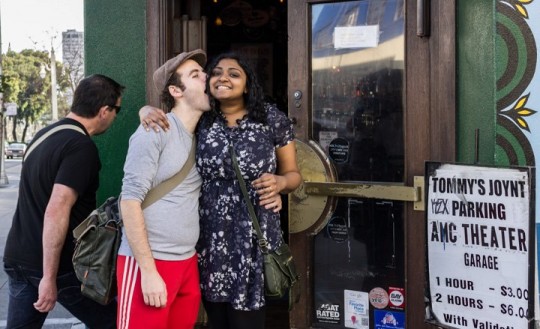
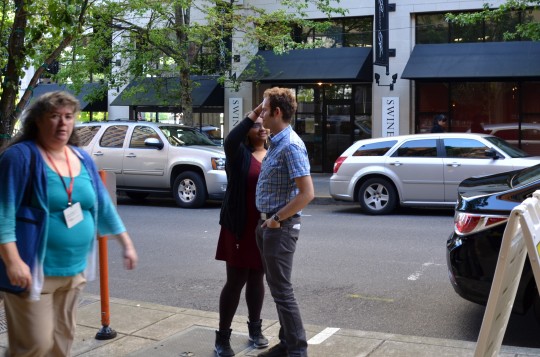

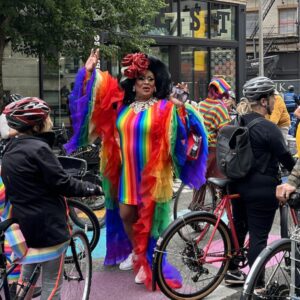



Thanks for reading.
BikePortland has served this community with independent community journalism since 2005. We rely on subscriptions from readers like you to survive. Your financial support is vital in keeping this valuable resource alive and well.
Please subscribe today to strengthen and expand our work.
I know it’s too late, but still I say: DON’T GO!
(Thanks for helping make this place a little better. You are missed already.)
The Pedestrian Advisory Committee would like to say NOOOOOOOOOOOO PLEASE DON’T GO, MELISSA AND BORIS! WHO WILL BRING THE URBAN PING-PONG NOW? (*sob*)
Ahem. That is to say, thank you for the creativity and inspiration you brought to the group and we wish you the best of luck in your new home.
Omg. I hit those ped signals randomly too! Nothing like a bit of intentional traffic calming!
That’s just annoying–and not only because bicycles are traffic, too. You’re not just lengthening the red interval for one direction, you’re also allowing the other direction a longer green interval. It’s a zero sum game, so you haven’t added any measure of calm.
Its not calming. Cars get zero mpg at a stoplight. You are part of a problem.
Oh come on now
I feel like it’s another way of being selfish with our transportation infrastructure. Why cause congestion if you don’t need to? do you want cars to be idling and emitting pollutants longer?
Yes, it is rude to randomly hit the pedestrian buttons. We’re constantly asking drivers to put themselves in our vulnerable position to create empathy for riders. Why would we not do the same for them? It is not a prank unless both parties enjoy it.
Making traffic stop unnecessarily is akin to vandalism– it hurts others without benefiting you. Cars that make extra, unnecessary stops pollute the air more when they re-accelerate, and emit more CO2 than they would otherwise.
I’ve met Boris and his wife and they’re lovely people. The world needs more folks like them.
Portland is going to miss you two so much!
Electric cars get infinite mpg at a red light :)). Its most annoying as a pedestrian to wait thru a whole cycle because the parallel walk didn’t come up cause you got there a second late. Thanks for giving us a walk, Boris.
“Portland spends way too much time working on master plans and not putting stuff on the ground.”
Amen brother!